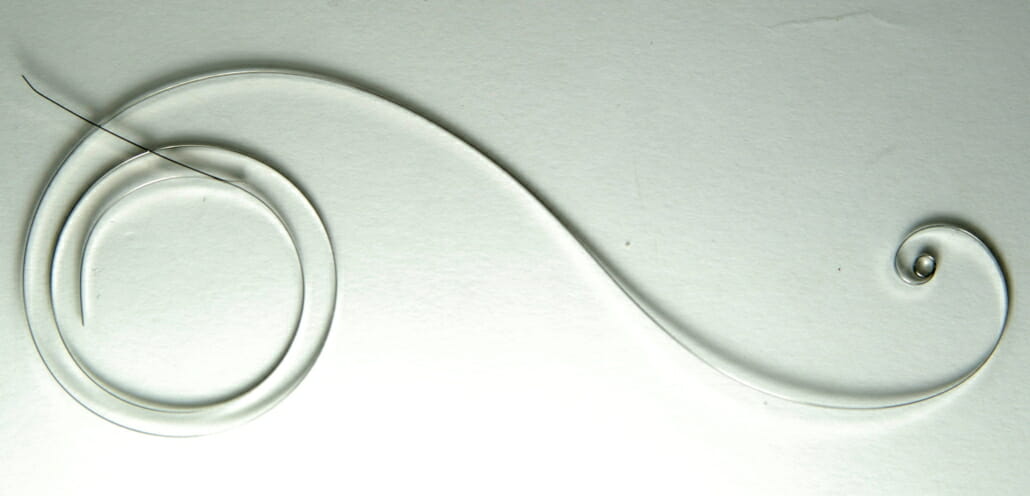While many men will consider or purchase a new wristwatch based solely on the looks of its exterior, the true connoisseur will give equal attention to its internal mechanisms. Such internal workings are collectively referred to as the movement or caliber of a wristwatch.
The movement drives the hands on the face of a wristwatch and also powers its other features, known in the trade as complications. These would include such things as the calendar, chronograph, or alternate time zones.
Watch Movements In General…
Watch movements can come in many different shapes and sizes in order to fit into the different shapes and sizes of watch cases that are available. As such, a watch movement could be round, rectangular, oblong, elliptical, and so on. The thickness of a watch movement is measured either in millimeters or in an old French unit called Ligne, in the case of French and Swiss watchmakers. One Ligne is equal to about 2.256 millimeters.
The individual parts of a watch movement are situated between two plates; the front plate which sits just behind the face of the watch has the same shape as the movement overall as well as the case, in general. The backplate, however, can have a few different shapes. It can be a full plate to match the front one, a ¾ plate or a series of smaller plates referred to as bridges. In the case of these latter two, it’s so that the individual parts of the movement can be more easily accessed when the watch needs to be repaired.
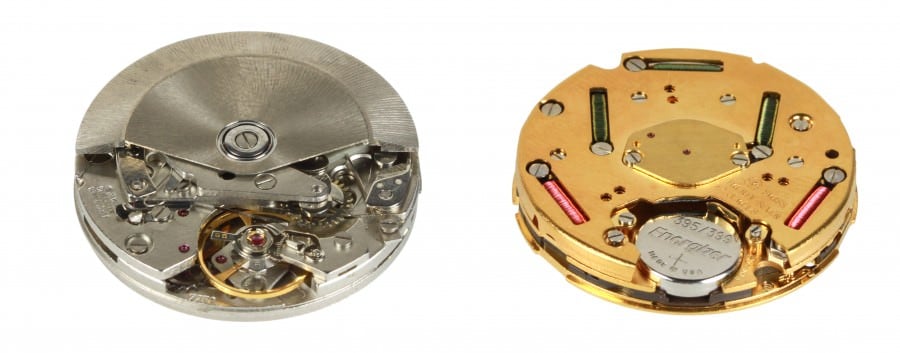
Mechanical Watch Movements
Speaking broadly, the mechanical category simply means that the watch in question isn’t powered by a battery. All mechanical watches, meaning both of the types we’re about to cover, will contain the following types of parts.
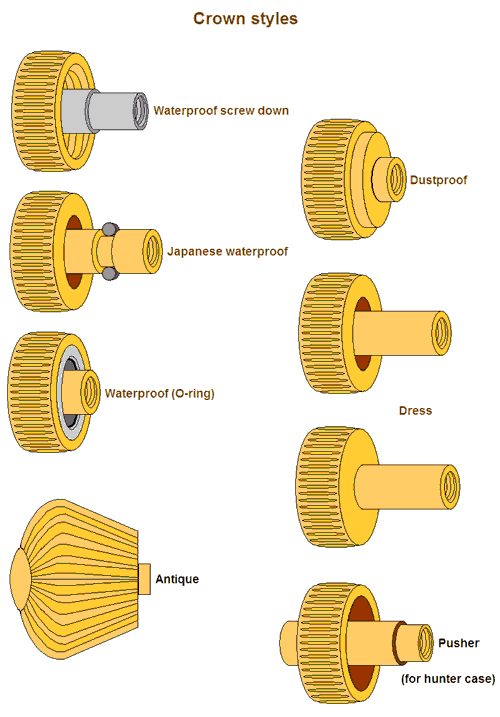
- The crown is the wheel on the side of the watch that is used to set the time, it can also be turned to wind the watch to run it.
- The mainspring is the power source of the movement and the kinetic energy from winding the crown is transferred to the coil shaped mainspring which stores the energy by getting tighter and tighter.
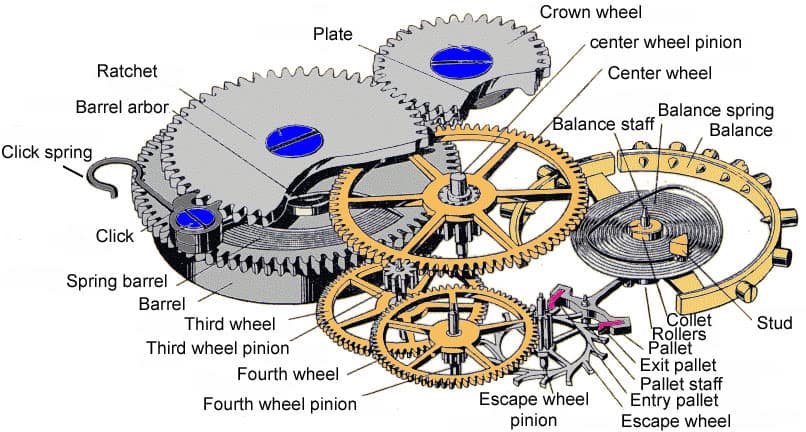
- The gear train transmits the stored energy from the mainspring to the escapement through a series of small gears.
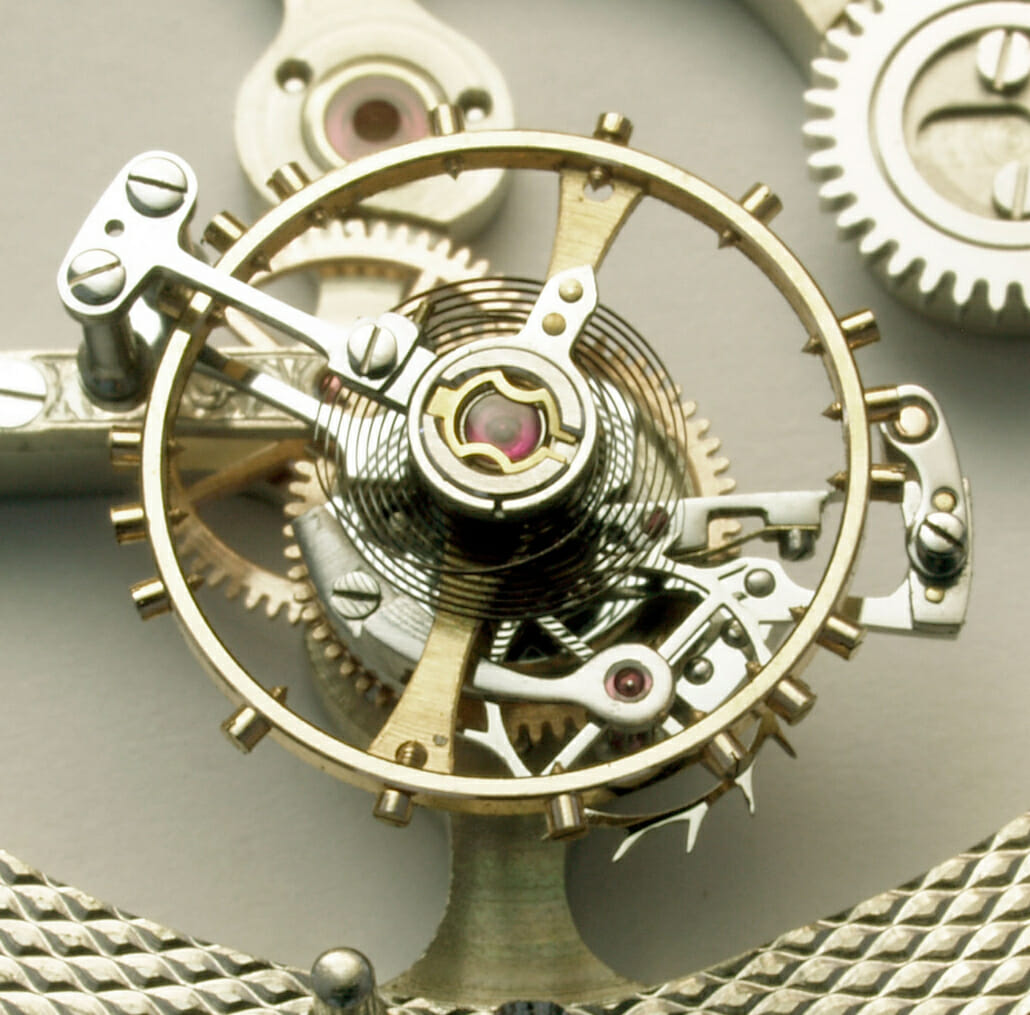
- The escapement also referred to as the escape wheel, is responsible for taking the energy from the mainspring and transferring it to the balance wheel in equally apportioned amounts. The balance wheel is essentially the heart of the watch movement; receiving the energy that it needs to run from the escapement. The balance wheel beats or oscillates in a circular motion between five and ten times per second. A watchmaker can make the balance wheel oscillate faster or slower which in turn makes the watch run faster or slower.
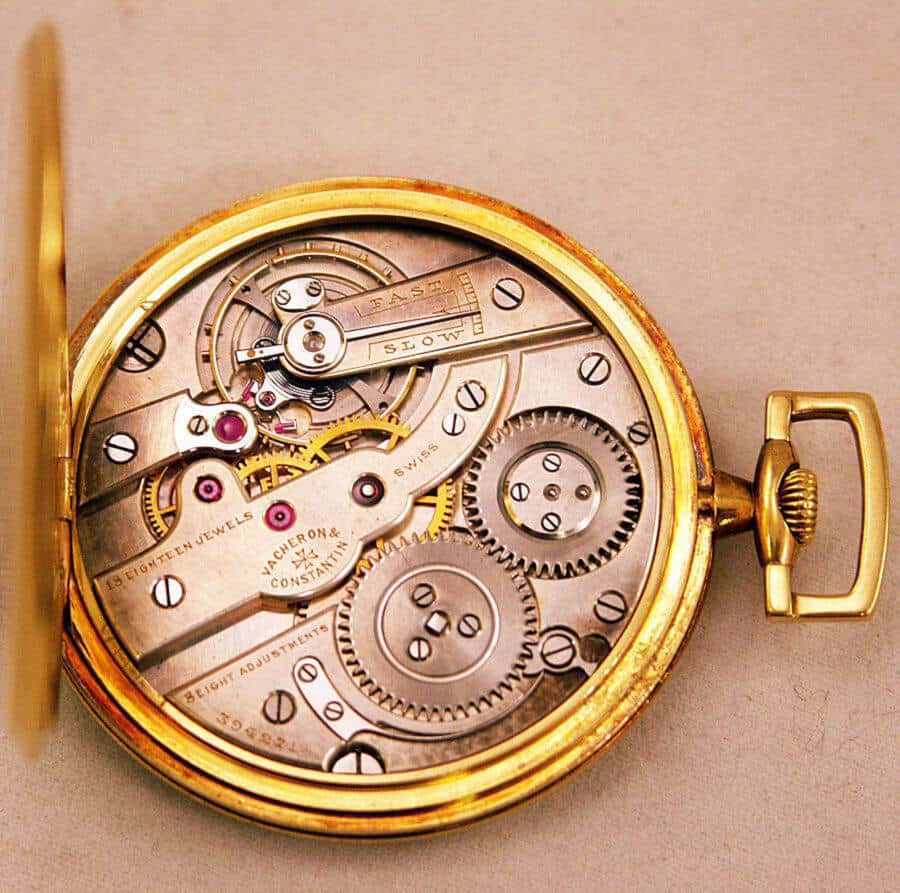
- Also of note here are the jewels, these are usually synthetic rubies that are set at points of high friction within the movement to reduce wear and improve performance. Rubies are used because they absorb heat well and they’re also extremely hard and therefore durable.
Why Are Mechanical Movement Watches Prized By Style Aficionados?
Simply put, the intricate small parts inside of the movements as well as the craftsmanship that goes into assembling them makes these movements pieces of art. Many European produced mechanical movement watches will sell for hundreds of thousands or even millions of dollars at auction. Though as with anything else, some of that price is due to brand name value.
Aside from just the considerations of artistry though, there are also practical benefits to mechanical movement watches. For one thing, with proper care, watches like this can last a lifetime and you won’t have to worry about constantly replacing batteries. On the other hand, mechanical watch movements can get dirty and the lubricants inside can dry up so they should be maintained by disassembling them and cleaning them every three to five years or so.
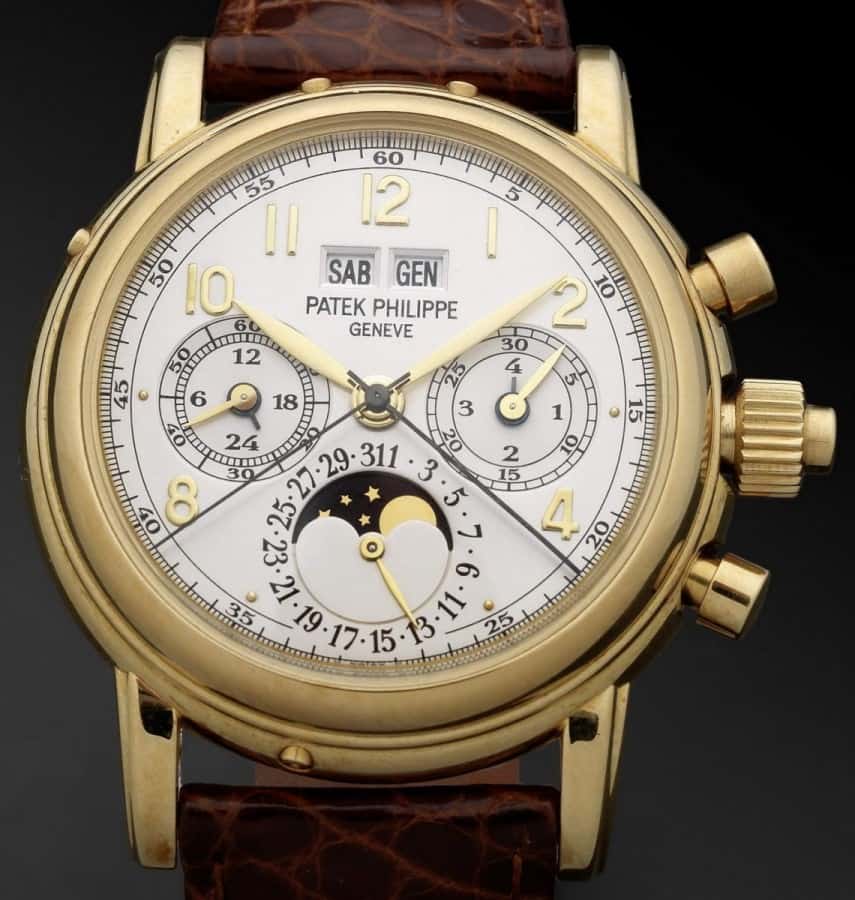
Manual Movement
A manual movement, also frequently referred to as a hand wound movement, is the oldest type of watch movement made. It dates back to the 16th century. Most manual movements will need daily winding in order to keep time accurately but some higher-end models can store energy efficiently enough to only need winding every few days.
Some watches will feature a complication known as a power reserve indicator which tells the wearer how long they can go before they actually need to wind the watch again. With this said though, men who prefer to wear manual movement watches generally get into the habit of winding them daily often at a set time, usually before they go to bed, for example. Because manual movements are the most traditional type of movement available, they’re typically found in conservatively styled expensive and collectible watch models.
Some important aspects to consider when purchasing a manual movement watch: First of all, you will need to get into the habit of winding your watch regularly. If you don’t do this, the watch will wind down and it won’t keep time accurately. With that said though, if a manual watch is wound too tightly or wound at an improper angle, say for example, if you try to wind it while it’s already on your wrist, this can do damage to the movement over time.
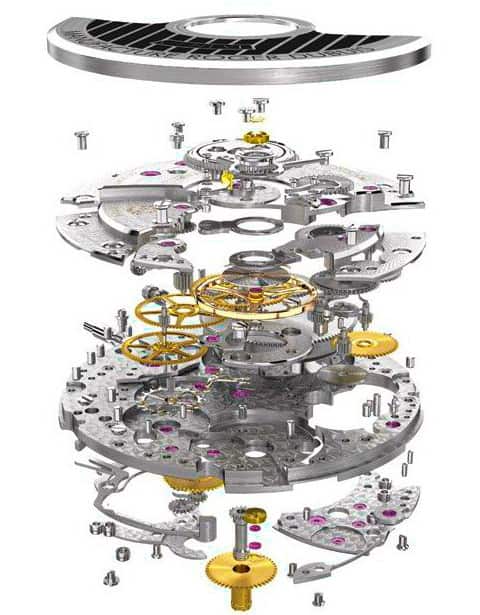
Automatic Movement
Along with manual movement watches, the other type of mechanical movement is the automatic movement, also known as the self-winding movement. This type debuted in the early 20th century. An automatic movement harnesses kinetic energy from the natural motion of the wearer’s wrist. In other words, moving your arm around while you’re wearing the watch throughout the day will wind the mainspring.
How is this accomplished then? It’s because an automatic movement contains all of the components we covered earlier plus an additional component that’s referred to as the rotor. This is most often a semi-circular metal weight that can swing freely 360 degrees as the wrist moves. The rotor is connected by another series of gears to the mainspring which gets wound as the rotor swings. From there, the mechanisms of the automatic movement are the same as the manual and yes, it can also be wound from the crown, if you so choose.
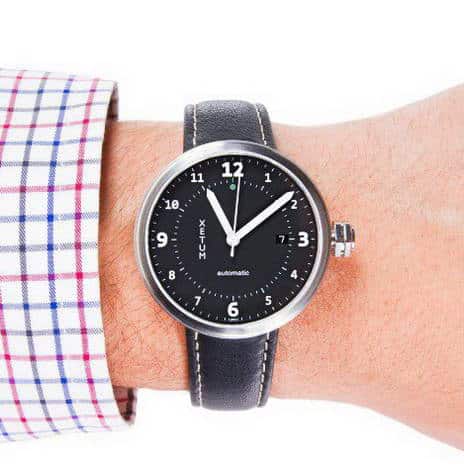
Some important aspects to consider when purchasing an automatic movement watch: starting with the fact that the ritual of daily winding isn’t necessary. As long as you wear the watch often and keep your wrist moving naturally, the watch will continue to get wound on the opposite side of the coin, however, if you go a long time without wearing an automatic movement watch, the lack of movement will probably mean that the watch will run down over time. Also, automatic movements are usually just a little bit thicker than manual movements because of the room that needs to be made for the rotor and additional gears. With that said, some gentlemen do appreciate the extra bit of heft that this brings to the watch.
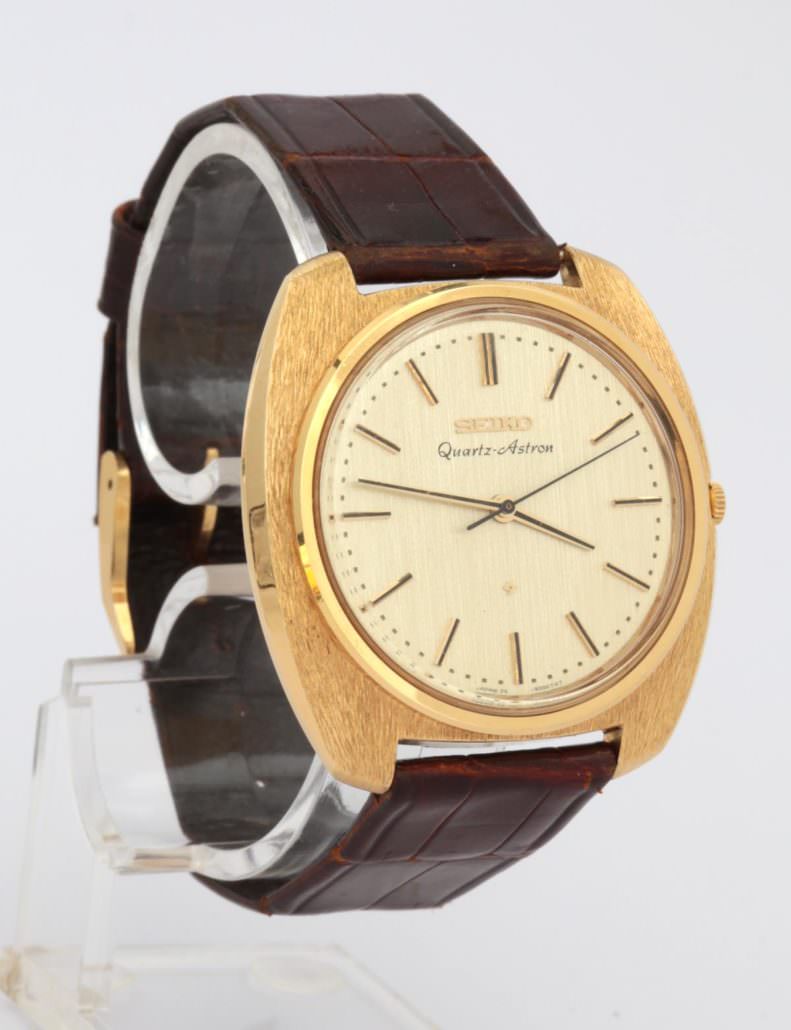
Quartz Movement
Also known as a battery-powered movement, it was introduced to the public by the Seiko corporation in 1969. Unlike the mechanical movements, the inner workings of a quartz movement are made up of very different components.
Firstly, the power source of a quartz movement is a battery. It takes the place of a mainspring. A watch battery will typically last between one and two years at which time it should be promptly replaced to prevent any leakage of battery acid.
Next up is the integrated circuit which carries the electrical charge from the battery to the quartz crystal and from the crystal to the stepping motor. The quartz crystal acts in a similar fashion to the escapement on a mechanical watch. Quartz vibrates when electricity is applied to it and this generates voltage. The stepping motor transforms the electrical impulses into mechanical power and the dial train functions just like the dial train that’s found on a mechanical movement.
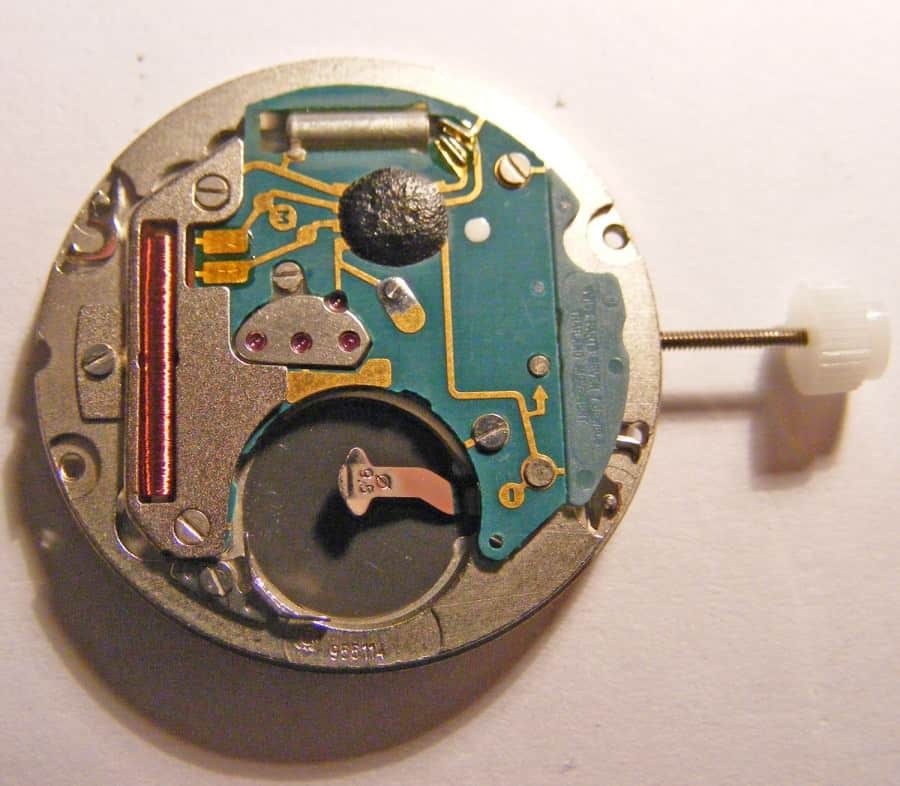
How Quartz Movements Work
First, the battery sends electricity through the integrated circuit to the quartz crystal. The electric charge makes the crystal vibrate at a rate of 32,768 pulses per second. These pulses are sent through the integrated circuit to the stepping motor which sends every 32,768 electrical pulse to the dial train. Ergo, this comes out to one pulse sent to the dial train per second. Finally of course, the dial train, as it did with the mechanical movements, moves the hands of the watch.
What Type Of Watch Movement Is Right For You?
In short, it really does depend on what specifically you’re looking for. If you’re a true watch connoisseur and you value the tradition and the craftsmanship that go into the construction of mechanical watches, then a manual or an automatic movement is probably going to be a good choice for you. Remember though that you will probably need to be willing to spend a bit more and that you’ll have to take the additional time to make sure that the watch is wound and running properly.
If you’d rather not deal with these additional factors, you’re just getting into the watch collecting hobby, or you just want one watch to use on a consistent basis, a quartz movement might be a better choice for you. You don’t have to feel that a quartz movement is inferior to a mechanical movement either. After all, they are the most accurate type of movement in the long run and there are still plenty of handsome styles of watch that contain quartz movements.
We’d like to know what were you most surprised by in today’s video? You can share with us in the comments section below.
Watch Movements Explained published first on https://mistiewyatt.tumblr.com/
